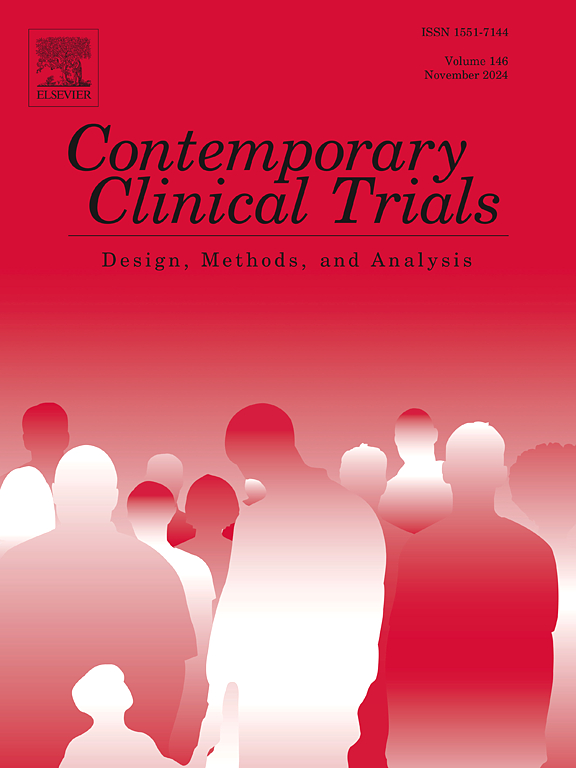评估迷走神经刺激和正念训练联合治疗偏头痛的脑机制:一项随机2 × 2因子临床试验方案
IF 1.9
3区 医学
Q3 MEDICINE, RESEARCH & EXPERIMENTAL
引用次数: 0
摘要
背景:偏头痛是致残的主要原因,需要有效的干预措施。在这项机制研究中,我们研究了多模式干预结合正念减压(MBSR)和经皮耳迷走神经刺激(taVNS)对偏头痛的联合和潜在的协同作用。方法:采用改进的双盲、安慰剂对照、2 × 2因子随机纵向设计,评估8周正念减压干预合并呼吸门控耳迷走传入神经刺激(RAVANS) taVNS对偏头痛病理生理主要结局的影响。我们将招募150名偏头痛患者(4-20头痛日/月)。经过一个月的日常日记,我们期望将N = 96名参与者随机分配到四个治疗组中的一个:(1)MBSR+RAVANS taVNS, (2) MBSR+假taVNS,(3)自然教育控制(NEC) +RAVANS taVNS,或(4)NEC +假taVNS。在干预前后,参与者进行三次面对面评估(7 T MRI扫描,自主/感觉测试(AST)访问和3 T PET-MRI扫描)。本研究的主要结果评估了(1)中枢致敏(脑干/皮层对三叉感觉传入的反应),(2)自主神经功能障碍(高频心率变异性(HF-HRV)对应激源的反应),以及(3)神经炎症(PET[11C]PBR28信号)。由NIH资助(P01AT009965),注册号(NCT03592329)。最终的纵向结果将于2025年5月收集。结论本机制研究旨在探讨MBSR和RAVANS taVNS干预对偏头痛三种不同病理生理机制的独立和协同神经生物学作用。本研究将阐明偏头痛的行为干预(如正念)和基于设备的治疗(如taVNS)的机制和潜在协同效应。本文章由计算机程序翻译,如有差异,请以英文原文为准。
Evaluating brain mechanisms of combined vagus nerve stimulation and mindfulness training for migraine: A randomized 2 × 2 factorial clinical trial protocol
Background
Migraine is a major cause of disability and efficacious interventions are needed. In this mechanistic study, we investigate the combined, and potentially synergistic, effects of a multimodal intervention combining Mindfulness-Based Stress Reduction (MBSR) and transcutaneous auricular Vagal Nerve Stimulation (taVNS) for migraine.
Methods
We utilize a modified double-blinded, placebo-controlled, 2 × 2 factorial randomized longitudinal design to assess the effects of an 8-week MBSR intervention with concomitant Respiratory-gated Auricular Vagal Afferent Nerve Stimulation (RAVANS) taVNS on migraine pathophysiology primary outcomes. We will enroll 150 patients with migraine (4–20 headache days/month). After a run-in month of daily diaries, we expect to randomly assign N = 96 participants to one of four treatment groups: (1) MBSR+RAVANS taVNS, (2) MBSR+Sham taVNS, (3) Nature Education Control (NEC) + RAVANS taVNS, or (4) NEC + Sham taVNS. Before and after intervention, participants have three in-person assessments (a 7 T MRI scan, an autonomic/sensory testing (AST) visit, and a 3 T PET-MRI scan). The primary outcomes for this study assess (1) central sensitization (brainstem/cortical response to trigeminal sensory afference), (2) autonomic dysfunction (High Frequency-Heart Rate Variability (HF-HRV) response to stressors), and (3) neuroinflammation (PET[11C]PBR28 signal).
Results
Funded by NIH (P01AT009965), registered (NCT03592329). Final longitudinal outcomes will be collected by May 2025.
Conclusion
This mechanistic study is designed to investigate both independent and synergistic neurobiological effects of MBSR and RAVANS taVNS interventions on three distinct pathophysiological mechanisms of migraine. This research will elucidate the mechanistic and potentially synergistic effects of behavioral interventions (e.g., mindfulness) and device-based treatments (e.g., taVNS) for migraine.
求助全文
通过发布文献求助,成功后即可免费获取论文全文。
去求助
来源期刊
CiteScore
3.70
自引率
4.50%
发文量
281
审稿时长
44 days
期刊介绍:
Contemporary Clinical Trials is an international peer reviewed journal that publishes manuscripts pertaining to all aspects of clinical trials, including, but not limited to, design, conduct, analysis, regulation and ethics. Manuscripts submitted should appeal to a readership drawn from disciplines including medicine, biostatistics, epidemiology, computer science, management science, behavioural science, pharmaceutical science, and bioethics. Full-length papers and short communications not exceeding 1,500 words, as well as systemic reviews of clinical trials and methodologies will be published. Perspectives/commentaries on current issues and the impact of clinical trials on the practice of medicine and health policy are also welcome.

 求助内容:
求助内容: 应助结果提醒方式:
应助结果提醒方式:


